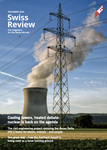As can be seen in the video above, amid record high temperatures in the Alps, in early August hikers found human bones on the Chessjen glacier in the southern canton of Valais. A week earlier, another body was found on the Stockji glacier near the resort of Zermatt, north-west of the Matterhorn.
In the first week of August, a mountain guide also discovered the wreckage of a plane that crashed on the Aletsch glacier, near the Jungfrau and Mönch mountain peaks, 50 years ago.
“There will be many more remains appearing from now on than we have seen in the past.”
Robert Bolognesi
snow science expert
Closer examination revealed the wreckage to be that of a small Piper Cherokee aircraft that crashed in the area on June 30, 1968, carrying a teacher, a chief medical officer and his son, all from Zurich. The bodies were recovered at the time, but the wreckage was not.
More bodies
Some experts believe that more and more bodies and objects will emerge on glaciers as the huge ice sheets continue to retreat at an accelerating rate.
“Climate change increases the melting of glaciers and accelerates the movement of a glacier,” Robert Bolognesi, a snow scientist and director of Meteorisk, told Swiss public television, RTS. “So bodies will be directed more quickly towards the bottom of the glacier.”
And with more people hiking in the mountains and crossing glaciers, the numbers are likely to rise. “There will be many more remains appearing from now on than we have seen in the past,” said Bolognesi.
As Swiss glaciers thin and recede, rare archaeological objects trapped in the ice, such as Neolithic wooden bows and quartz arrowheads, also frequently emerge. The Valais authorities have a special archaeological service that collects and researches the finds.
They have also developed a mobile phone app – the Icewatcher app – to encourage the public to report any unusual objects encountered while out in the mountains or on glaciers.
After a winter with relatively little snowfall, the Swiss Alps have experienced a severe summer heatwave. Scientists warn that almost all the ice sheets in the Swiss Alps could disappear by 2090 due to climate change.
About the author | Born in London, Simon Bradley is a multimedia journalist who has worked for www.swissinfo.ch since 2006. He speaks French, German and Spanish and focuses on science, technology and innovation issues.
About the video journalist | Céline Stegmüller joined swissinfo.ch in 2018 as video journalist for the 'Nouvo in English' project, just after?graduating?from the Academie du journalisme et des medias (AJM) at the University of Neuchâtel. Originally from Ticino, she's?been filming, writing and interviewing people all over Switzerland since she got her first reporter badge at 11 during a?school camp.?
www.swissinfo.ch | original article












Comments